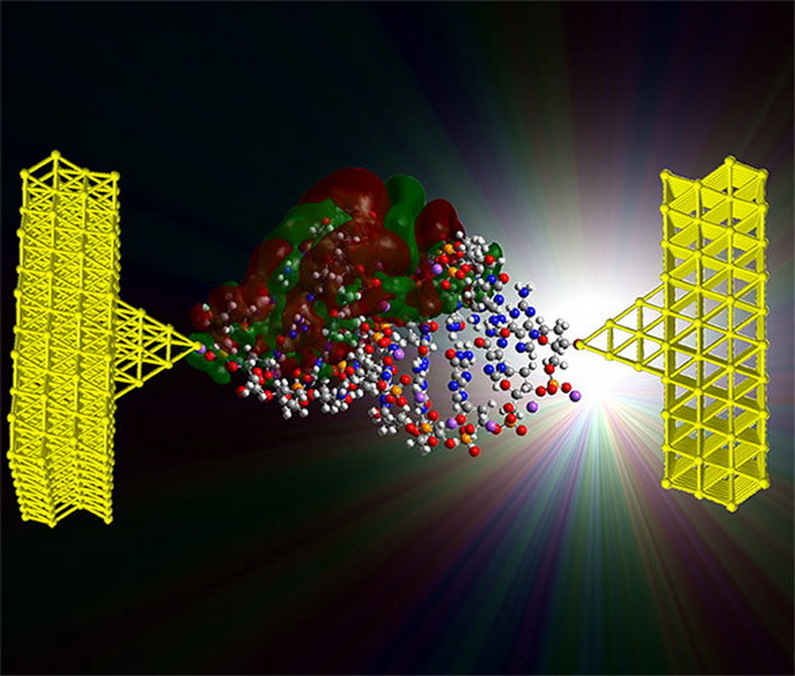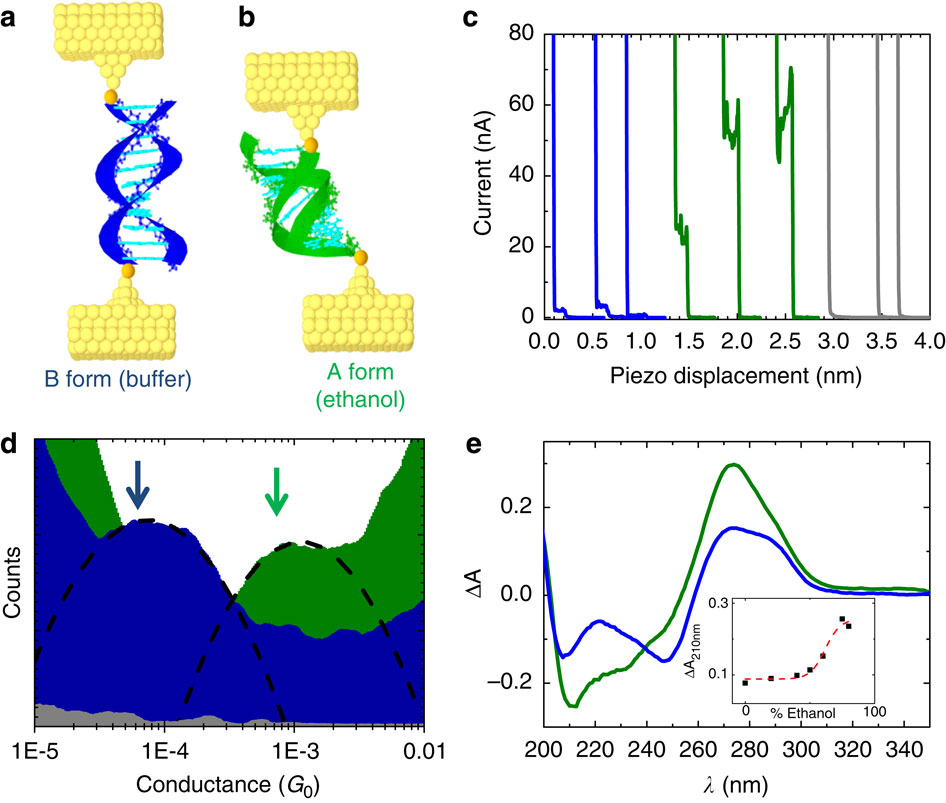DNA as an electromechanical switch for nanoscale computing
Welcome to the iCover Blog Pages ! As a joint group of researchers from the University of Washington and California proved, a change in the structure and shape of a DNA molecule entails a change in its electrical conductivity. Such a dependence, according to scientists, allows the use of a DNA molecule as a microscopic electromechanical switch that can be used in nanoscale molecular computing devices of a new generation.

DNA molecules are carriers of genetic information that ensures the maintenance of all life forms known to us. At the same time, the specifics of the structure and properties of DNA molecules are increasingly viewed by scientists as the possibility of their use as a unique “building” nanomaterial. In their experiments, a group of specialists came to the conclusion that the shape of the DNA molecule varies depending on the chemical environment in which it is located. The next fundamental conclusion was the observation that with a change in the shape and structure of the molecule within certain limits, it led to a change in its electrical conductivity. Thus, in some conditions, the DNA molecule behaved as an insulator, in others, as a full-fledged conductor of electric current.
Knowing the principles of the mechanism of changing the electrical conductivity of DNA and the ability to modulate the electric current with it, it will be possible to create functional nanoscale devices similar to transistors of modern microprocessors, but working on principles radically different from those used in modern electronics. ”The tendency to reduce the overall dimensions of the components of electronic devices inevitably entails their complication and appreciation. At the same time, DNA-based devices can be programmed in such a way that they become fully self-assembled and functional, ”explained Josh Hihath, Head of the Research Group, Assistant Professor, Department of Electrical and Computer Engineering, University of California, Davis. The scientist is convinced: millions of active and functional molecular devices can be combined in electronic circuits of the future. And the indisputable advantage of such schemes will be their minimum energy consumption.
According to scientists, the technology of dynamic control and change in the shape of the molecule will allow turning a DNA molecule into a functional electromechanical switch. The switching cycles in the experiment corresponded to one of two stable forms of the molecule - the so-called. “A” and “B” forms.
The role of the A-form was played by a perfectly familiar right-handed twisted helix of a duplex DNA molecule. When ethanol was exposed to it, the molecule contracted, acquiring a more compact B-shape, in which individual base pairs and individual sections were located at different angles of inclination with respect to each other. The obtained B-form of the molecule showed increased electrical conductivity. Removing ethanol from the environment allowed the molecule to return to its original A-form with a conductivity of at least an order of magnitude lower than in the case of Form B. In other words, the process under consideration is completely reversible and can be repeated many times.

Of course, scientists at both universities have so far taken only the first, but important steps - it has been experimentally confirmed that a directionally variable DNA molecule acquires properties that allow it to be used in molecular and bioelectronics. The question so far remains unanswered: how will the state of each of the components of the logic diagram of nanoscale molecular components and the control of the general scheme be controlled. No less interesting is the question of the speed of such "molecular" schemes.
“As a result, we will be able to find a solution that allows us to change the shape of the molecule not by chemical exposure, but by an electrical signal or a certain mechanical method,” Josh Heath said. - "... This will give us the opportunity to individually control each of the components, and hence the creation of molecular electronic circuits of any complexity from them." By analogy with ancient Japanese art, the method used by American scientists to create any self-assembled two- and three-dimensional nanoscale structures is called “DNA origami”.
For more information on the results of the experiment, see the publication pages in the journal Nature Communications .
Source .
Dear readers, we are always happy to meet and wait for you on the pages of our blog. We are ready to continue to share with you the latest news, review articles and other publications and will try to do our best to make the time spent with us useful for you. And, of course, do not forget to subscribe to our columns . Our other articles and events


DNA molecules are carriers of genetic information that ensures the maintenance of all life forms known to us. At the same time, the specifics of the structure and properties of DNA molecules are increasingly viewed by scientists as the possibility of their use as a unique “building” nanomaterial. In their experiments, a group of specialists came to the conclusion that the shape of the DNA molecule varies depending on the chemical environment in which it is located. The next fundamental conclusion was the observation that with a change in the shape and structure of the molecule within certain limits, it led to a change in its electrical conductivity. Thus, in some conditions, the DNA molecule behaved as an insulator, in others, as a full-fledged conductor of electric current.
Knowing the principles of the mechanism of changing the electrical conductivity of DNA and the ability to modulate the electric current with it, it will be possible to create functional nanoscale devices similar to transistors of modern microprocessors, but working on principles radically different from those used in modern electronics. ”The tendency to reduce the overall dimensions of the components of electronic devices inevitably entails their complication and appreciation. At the same time, DNA-based devices can be programmed in such a way that they become fully self-assembled and functional, ”explained Josh Hihath, Head of the Research Group, Assistant Professor, Department of Electrical and Computer Engineering, University of California, Davis. The scientist is convinced: millions of active and functional molecular devices can be combined in electronic circuits of the future. And the indisputable advantage of such schemes will be their minimum energy consumption.
According to scientists, the technology of dynamic control and change in the shape of the molecule will allow turning a DNA molecule into a functional electromechanical switch. The switching cycles in the experiment corresponded to one of two stable forms of the molecule - the so-called. “A” and “B” forms.
The role of the A-form was played by a perfectly familiar right-handed twisted helix of a duplex DNA molecule. When ethanol was exposed to it, the molecule contracted, acquiring a more compact B-shape, in which individual base pairs and individual sections were located at different angles of inclination with respect to each other. The obtained B-form of the molecule showed increased electrical conductivity. Removing ethanol from the environment allowed the molecule to return to its original A-form with a conductivity of at least an order of magnitude lower than in the case of Form B. In other words, the process under consideration is completely reversible and can be repeated many times.

Of course, scientists at both universities have so far taken only the first, but important steps - it has been experimentally confirmed that a directionally variable DNA molecule acquires properties that allow it to be used in molecular and bioelectronics. The question so far remains unanswered: how will the state of each of the components of the logic diagram of nanoscale molecular components and the control of the general scheme be controlled. No less interesting is the question of the speed of such "molecular" schemes.
“As a result, we will be able to find a solution that allows us to change the shape of the molecule not by chemical exposure, but by an electrical signal or a certain mechanical method,” Josh Heath said. - "... This will give us the opportunity to individually control each of the components, and hence the creation of molecular electronic circuits of any complexity from them." By analogy with ancient Japanese art, the method used by American scientists to create any self-assembled two- and three-dimensional nanoscale structures is called “DNA origami”.
For more information on the results of the experiment, see the publication pages in the journal Nature Communications .
Source .
Dear readers, we are always happy to meet and wait for you on the pages of our blog. We are ready to continue to share with you the latest news, review articles and other publications and will try to do our best to make the time spent with us useful for you. And, of course, do not forget to subscribe to our columns . Our other articles and events

- A selection of New Year's gifts up to 2016 rubles from iCover
- Sports headset Jabra Sport Pace.
- Sports family: Jawbone UP3 and UP2 with the forgotten fellow UP24
- One manufacturer - different fates: external HDD LaCie P'9220 1 TB and Rugged Triple 2 TB
- Harman Kardon New Year's Gifts
- Exclusive Records from iCover and Warner Music
- 20% discount on futurism and classics
